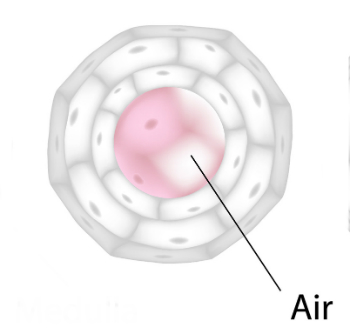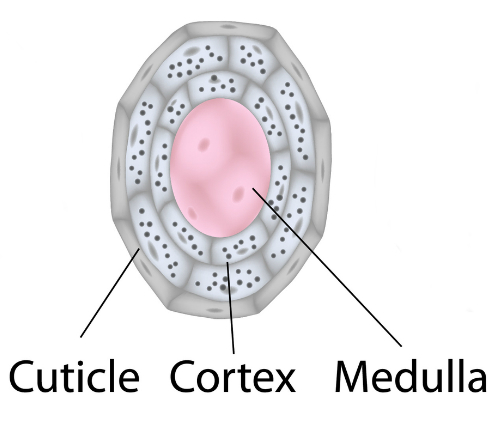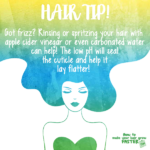Hello Lovelies!
You know, hair is pretty amazing. It’s fairly obvious that I’m obsessed with hair, the outwardly appearance of hair that we see from day to day. However, when you scratch beyond the surface and look at the physical structure of hair, you’ll see that hair, more specifically the hair shaft, is a pretty amazing engineering feat of nature.
Human hair is composed of just three components, or layers, which include the cortex, the medulla and the cuticle. Here is a breakdown of each component.
The Medulla
 The medulla is the innermost portion of the hair shaft. The medulla consists of hollow spaces of air and round cells. The medulla’s presence and appearance can differ from person to person and even within the strands of hair on one person’s head. For instance, you may have some hair strands that contain a complete medulla, a partial or fragmented medulla, or no medulla at all. Thicker hair types tend to have a medulla, but finer hair types have no medulla at all.
The medulla is the innermost portion of the hair shaft. The medulla consists of hollow spaces of air and round cells. The medulla’s presence and appearance can differ from person to person and even within the strands of hair on one person’s head. For instance, you may have some hair strands that contain a complete medulla, a partial or fragmented medulla, or no medulla at all. Thicker hair types tend to have a medulla, but finer hair types have no medulla at all.
The exact function of the medulla has yet to be determined, but for the most part the medulla typically supplies evidence to the species from which a particular hair derived from (i.e. human hair medullas differ from dog hair medullas and so forth), and in the case of humans, the medulla tells us which area of the body a particular hair came from (head hair medullas differ from body hair medullas).
The Cortex
The cortex makes up 70 to 95 percent of the hair’s total mass. The cortex is the foundation of our hair’s color, shape, strength and elasticity. The cortex is made up of cells and long strands of keratin protein, and these strands act as rubber bands and give the hair its strength or elasticity. If you stretch a strand of your hair, then let it go, a healthy hair will bounce back to it’s original shape. An unhealthy hair will succumb to the stretching and most likely not return to it’s original shape, or worse, break in the process of stretching. This is due to a weakened and inelastic cortex.
The Cuticle
The cuticle layer acts as a protective shield for the protein inside the cortex. The cuticle is made up of various layers that form a shingle-like structure, and these “shingles” can open and close to control the flow of moisture and water that enters and exit’s the hair’s cortex. The cuticle is mostly responsible for how our hair looks (i.e. shine of the hair) and feels. The hair’s cuticle is the most important factor in growing long hair. Let me say that again so it sinks in. The hair’s cuticle is the absolute most important factor in growing long hair. It’s so important, it can’t be summed up or described in a small section of an article, so I’ve dedicated a category of this website to the preservation of the hair’s cuticle.
Characteristics of Hair Types
No matter your hair type, all human hair as the same structure. However, it is the individual structure of our hair that gives it a certain texture. Confusing, right? Well, let me explain further.
Hair science recognizes that there are three main categories in regards to human hair, Caucasian Hair, Asian hair and African hair. The things that give these hair categories their differences can be explained in the hair’s structure, or more rather how the hair‘s cuticle and cortex is formed and behaves.
Before I go in-depth about the differences between the hair categories, let me explain something further about the cortex (I promise it’ll tie into how the individual hair categories behave). Remember those cells I mentioned up above that make up the cortex along with keratin, those cells are known as paracortical cells and orthocortical cells.
Paracortical cells are stronger than orthocortical cells because they contain a higher amount of cystine, which is the most abundant amino acid found in hair, a larger matrix, and stable disulfide bonds. These cells are also the larger and rounder of the two cells. Orthocortical cells are the weaker of the two because the matrix is smaller, the cells contain less cystine, and the di-sulfide bonds between the hair aren’t as stable. The arrangement of these cells differ between the hair categories and greatly explains the differences in texture and strength between the categories. The difference in the cuticle layers between each hair category also explains the differences in how each hair type behaves.
African Hair
If you looked at a cross section of African hair under a microscope, it would have an elliptic shape. African hair strands are not round, they are flat, and as you go down the hair strand, you’ll find twists and turns known as kinks. At every kink, the hair is much thinner and susceptible to breakage and damage.
African hair tends to have fewer cuticle layers than any other hair category, and due to the hair’s flat structure, the cuticle layers tend to be raised. This makes highly textured hair even more susceptible to damage if you don’t know how to take care of it the right way.
Now for the connection I spoke about earlier between the arrangement of paracortical and orthocortical cells in the cortex and the texture of the individual hair categories. Well, here it goes. African hair has identical chains of paracortical and orthocortical cells along the hair‘s cortex, which is precisely why the hair curls up significantly! Since paracortical cells are present on the inside of the crimp, and orthocortical cells are present on the outside of the crimp, they sort of cancel each other out along the hair strand, so the hair curls up because there is nothing to balance out the kinks. Make sense?
Asian Hair
When you look at a cross section of Asian hair, it is perfectly round, and it’s the only hair category whose cross section is perfectly round. Asian hair has only paracortical cells, which explains why Asian hair is naturally straight. The hair’s cuticles also lay flat in their natural state, which makes Asian hair stronger, and better at retaining moisture than any other hair type.
Caucasian Hair
The cross section of Caucasian hair ranges between elliptic to oval in shape. Caucasian hair has a narrow chain of orthocortical cells, but mostly consists of paracortical cells, which explains why the majority of Caucasian women have some sort of natural bend or waves in their hair. The cuticle tends to lay flat just like Asian hair, so Caucasian hair is good at reflecting light, retaining moisture and much stronger than African hair, but not as strong as Asian hair.
Lovelies, these differences are precisely why one-size fits all hair care advice does not work. You must develop a hair care regimen based on your hair type and your hair’s individual needs. All hair may have the same underlying structure, but all hair cannot and should not be treated the same if you want to grow it long. As I always say, what works for one person, or one hair type, may not work for you. So hopefully this explanation behind the structure of hair helps you see why it is so very important to develop a hair care regimen of your own.



